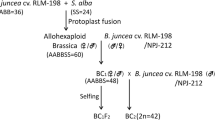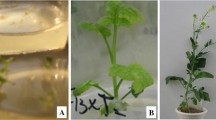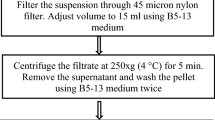Abstract
Two accessions of Lycopersicon peruvianum Mill. (PI270435, PI126443) carrying Mi-2 and Mi-3, respectively, new root-knot nematode resistance genes, were selected as the male parents for crosses with L. esculentum Mill. in order to produce interspecific hybrids. Crossability barriers between these two distantly related species were circumvented by ovule culture. A total of ten interspecific F1 hybrid plants were produced. The hybrid nature of the putative F1 plants was confirmed by a comparison of several morphological characteristics and a PCR-based assay. Eight of ten hybrid plants were backcrossed with L. esculentum to generate a total of 98 BC1 progeny. Two lines were advanced to the BC2 and BC3 levels. Based on these results, ovule culture was found to be an effective method for the production of novel interspecific F1 and BC1 plants.
Similar content being viewed by others
References
Barbano, P.P. & L.D. Topoleski, 1984. Postfertilization hybrid seed failure in Lycopersicon esculentum × Lycopersicon peruvianum ovules. J Amer Soc Hort Sci 109: 95–100.
Chen, L.Z. & T. Adachi, 1992. Embryo abortion and efficient rescue in interspecific hybrids, L. esculentum and the ‘peruvianum complex’. Jpn J Breed 42(1): 65–77.
Chen, L.Z. & S. Imanishi, 1991. Cross-compatibility between the cultivated tomato L. esculentum and the wild species L. peruvianum, L. chilense assessed by ovule culture in vitro. Jpn J Breed 41(2): 223–230.
Chunwongse, J., 1995. Development and utilization of PCR-based molecular marker assays in monocot-and dicotyledonous crop species. PhD Dissertation, Cornell University, Ithaca, NY.
Ehlenfeldt, M.K. & R.E. Hanneman Jr., 1989. Genetic control of endosperm balance number (EBN): three additive loci in a threshold-like system. Theor Appl Genet 75: 825–832.
Fulton, T.M., J. Chunwongse & S.D. Tanksley, 1995. Microprep protocol for extraction of DNA from tomato and other herbaceous plants. Plant Mol Biol Rep 13(3): 207–209.
Gilbert, J.C. & D.C. McGuire, 1956. Inheritance of resistance to severe root-knot from M. incognita in commercial type tomatoes. Proc Am Soc Hort Sci 68: 437–442.
Hogenboom, N.G., 1972. Breaking breeding barriers in Lycopersicon. 1. The genus Lycopersicon, its breeding barriers and the importance of breaking these barriers. Euphytica 21: 221–227.
Hogenboom, N.G., 1975. Incompatibility and incongruity: two different mechanisms for the nonfunctioning of intimate partner relationships. Proc R Soc London Ser B 188: 361–375.
Imanishi, S., Y. Watanabe & I. Hiura, 1985. A simple and efficient method for interspecific hybridization between L. esculentum and L. peruvianum. J Yamagata Agr For Soc 42: 13–15.
Medina-Filho, H.P. & M.A. Stevens, 1980. Tomato breeding for nematode resistance: survey of resistant varieties for horticultural characteristics and genotypes of acid phosphatases. Acta Hort 100: 382–393.
McGuire, D.C. & C.M. Rick, 1954. Self-incompatibility in species of Lycopersicon sect. Eriopersicon and hybrids with Lycopersicon esculentum. Hilgardia 23: 101–112.
Murashige, F. & F. Skoog, 1962. A revised medium for rapid growth and bioassays with tobacco tissue cultures. Physiol Plant 15: 473–497.
Neal, C.A. & L.D. Topoleski, 1983. Effects of the basal medium on growth of immature tomato embryos in vitro. J Am Hort Sci 108(3): 434–438.
Pilowski, M. & S. Cohen, 1990. Tolerance to tomato yellow leaf curl virus derived from L. peruvianum. Plant Dis 74: 248–250.
Rick, C.M., 1982. The potential of exotic germplasm for tomato improvement. In: J.K. Vasil, W.R. Scrowcroft & K.J. Frey (Eds.), Plant Improvement and Somatic Cell Genetics, pp. 1–28. Academic Press, New York.
Rick, C.M., 1986. Reproductive isolation in the L. peruvianum complex. In: W.D. D'Arcy (Ed.), Solanaceae. Biology and Systematics, pp. 477–495. Colombia University Press, New York.
Saccardo, F., G. Ancora & K.S. Ramulu, 1981. Transfer of useful characters from L. peruvianum to L. esculentum tomato hybrids. Proc Eucarpia Tomato Working Group May, pp. 235–242.
Smith, P.G., 1994. Embryo culture of a tomato species hybrid. Proc Am Soc Hort Sci 44: 413–416.
Taylor, I.B., 1986. Biosystematics of the tomato. In: J.G. Atherton & J. Rudich (Eds.), The Tomato Crop. A Scientific Basis for Improvement, pp. 1–34. Chapman & Hall, London.
Thomas, B.R. & D. Pratt, 1981. Efficient hybridization between Lycopersicon esculentum and L. peruvianum via embryo callus. Theor Appl Genet 59: 215–219.
Yamakawa, K., H. Yasui, T. Mochizuki, K. Hida & S. Komucki, 1987. Incorporation of disease resistance from L. peruvianum to cultivated tomatoes. I. Breeding of new varieties having resistance to fusarium crown rot and tobacco mosaic virus inherited from L. peruvianum. Bull Natl Res Int Veg Ornamental Plants Tea Ser A (1): 1–38.
Author information
Authors and Affiliations
Rights and permissions
About this article
Cite this article
Doganlar, S., Frary, A. & Tanksley, S.D. Production of interspecific F1 hybrids, BC1, BC2 and BC3 populations between Lycopersicon esculentum and two accessions of Lycopersicon peruvianum carrying new root-knot nematode resistance genes. Euphytica 95, 203–207 (1997). https://doi.org/10.1023/A:1002949700854
Issue Date:
DOI: https://doi.org/10.1023/A:1002949700854




